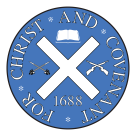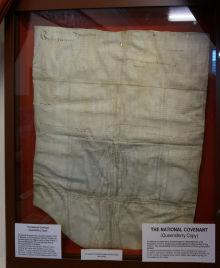Scottish Covenanter Memorials Association
Many search engines bring you to this page first!
If you want to go to our Home Page, click here, or else click the round badge at the top of the page.
Who were the Covenanters?
Simply stated, the Covenanters were those people in Scotland who signed the National Covenant in 1638. They signed this Covenant to confirm their opposition to the interference by the Stuart kings in the affairs of the Presbyterian Church of Scotland.
The Stuart kings harboured the belief of the Divine Right of the monarch. Not only did they believe that God wished them to be the infallible rulers of their kingdom - they also believed that they were the spiritual heads of the Church of Scotland. This latter belief could not be accepted by the Scots. No man, not even a king, could be spiritual head of their church. Only Jesus Christ could be spiritual head of a Christian church.
This was the nub of the entire Covenanting struggle. The Scots were, and would have been, loyal to the Stuart dynasty but for that one sticking point, and from 1638, when the Covenant was signed, until the Glorious Revolution - when Prince William of Orange made a bloodless invasion of Great Britain in 1688 - a great deal of suffering, torture, imprisonment, transportation and executions would ensue.
King Charles I had introduced the Book of Common Prayer to Scotland in 1637 to the fury and resentment of the populace. He declared that opposition to the new liturgy would be treason, and thus came about the Covenant.
There followed a period of very severe repression. Ministers with Covenanting sympathies were "outed" from their churches by the authorities, and had to leave their parishes. Many continued to preach at "conventicles" in the open air or in barns and houses. This became an offence punishable by death. Citizens who did not attend their local churches (which were now in the charge of Episcopalian "curates") could be heavily fined, and such offenders were regarded as rebels, who could be questioned, even under torture. They could be asked to take various oaths, which not only declared loyalty to the king, but also to accept his as head of the church. Failure to take such an oath could result in summary execution by the muskets of the dragoons, who were scouring the districts looking for rebels.
The persecutions became more frequent and cruel on the Restoration of Charles II in 1660. As time went on more and more ordinary folk became involved, and skirmishes and battles took place against Government troops. In 1678 the Government raised an army of 6,000 Highlanders (the 'Highland Host'), who had no love for the Presbyterian lowlanders. This army swept through the west and south of Scotland, looting and plundering. They remained for many years, quartering themselves on the already impoverished Covenanters.











